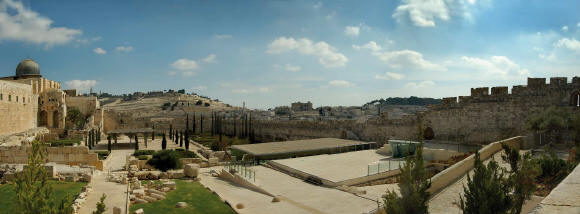Al-Aqsa Mosque
Al Habtoor Information & Research

At the heart of Jerusalem is the Noble
Sanctuary, Al-Haram al-Sharif, over 35 acres, most
of it is open areas. It comprises large square of
fountains, gardens, buildings and domes. At one
end of the place is the main mosque, Al Masjid Al
Qibli, with its lead plated dome while at its
centre the golden Dome of the Rock. The entire
area is surrounded with Al Aqsa wall, over it Al
Aqsa’s four minarets rise.
Al Aqsa name is used to
describe the whole area surrounded by the wall at
the southern-eastern end of walled old Jerusalem.
The place encompasses more than 200 buildings,
domes, schools, wells, etc. Then it is not only
the mosque with the golden dome, the Dome of the
Rock, nor the mosque with lead dome, Al Masjid Al
Qibli. Both of them are part of the walled Al Aqsa
mosque.
Adam (PBUH) was the first to build Al Aqsa, the
area enclosed by the wall which has not changed
since then. Before that there was no other
building. The place was reconstructed by Abraham (PBUH)
2000 BC. Constructions were done after that by his
progeny- Isaac, Jacob. Solomon renovated it in
1000 BC.
In Islamic era, Umayyad caliphs were the first to
build Al Aqsa Mosque according to its current
configuration. They built the Dome of the Rock and
Al Masjid Al Qibli. Construction works lasted for
30 years. Renovations and additional structures
were made later on by Abbasid, Ayyobian, Ayoubi,
Mamluke, and Ottoman caliphs.
According to Islam teachings, a prayer in Al
Masjid Al Aqsa- whether inside the Dome of the
Rock, Al Masjid Al Qibli, underneath any of its
trees, or underneath any of its domes- is
equivalent to many prayers elsewhere. That is
because all the walled area is actually Al Masjid
Al Aqsa, not like what Israeli Media alleges
saying the Al Masjid Al Aqsa is only the Dome of
the Rock or Al Masjid Al Qibli. Israel wants
Islamic to forget that all the walled area is Al
Aqsa, the third most holy land for Muslims.
Al Aqsa has five closed gates and 10 open gates.
The latter are: Asbat, Hitta, Prophets (Faisal),
Ghawaima (Al Khalil), Al Nazir, Hadeed, Qattaneen,
Mutawadaa (Mutahara), Silsila, and Magharibah.
Al Magharibah Gate
Al Magharibah gate is located at the western side
of Al Aqsa’s wall. A rump was constructed over
sand hill to make a single unit with the wall.
Therefore, the rump and the hill are indispensable
part of Al Aqsa. The gate and the road reaching is
has been used by Muslims to reach Al Aqsa for
prayers for centuries. The gate was named after
the neighborhood to the west of the wall, Al
Magharibah, which was inhabited by migrants from
North Africa (Al Magrib) who came to Jerusalem
after being liberated from Crusaders by Salahuldin.
In 1967, Israel occupied East Jerusalem and seized
Al Magharibah neighborhood on the pretext that it
overlooked Al Buraq Wall (Wailing Wall as it is
called by Israelis). Israel claimed that Al Buraq
was a part of their alleged temple. They leveled
the entire place regardless the many Islamic
historical buildings exiting there and named the
place as wailing square. It was one of the early
steps taken by the Israelis to impost Jewish
identity on the entire Jerusalem old city.
Israelis seized the keys of Al Magharibah Gate and
prevented Muslims from using it since 1967. Only
Jews and foreign tourists are permitted to use the
gate. It has been used also by Israeli military to
enter Al Aqsa.
Not only this, since 1967 Al-Masjid Al-Aqsa has
been the target of several attempts by the
Israelis to destroy or burn it, including several
attempts to bring about its collapse through
underground excavations on the pretext of
searching for the alleged temple.
The excavation destabilized the hill upon which Al
Magharibah Gate is located. On 15 February 2004, a
100 meters long part of the wall collapsed. Last
year Israelis said they would remove the entire
historical road. This would constitute a mass
abuse of Al Aqsa Mosque. Apart from being integral
part of Al Aqsa, the hill and the road support the
wall. Demolishing them will inevitably destabilize
the foundations of Al Aqsa.
Al Aqsa was the first qibla for Muslims; they used
to turn towards it when they prayed. It is the
second house of God after Kaabah in Mecca, and the
third holiest site in Islam.
It was the place at which Prophet Mohammad, PBUH,
made his Miraj- ascending to skies- during Al Isra
and Miraj (Night Journey). There he led prophets
in congregation prayers. Prophet Mohammed, PBUH,
took the journey in a single night from the Sacred
Mosque to Al Masjid Al Aqsa. From the Rock there,
Prophet Mohammad, PBUH, ascended to heaven where
he received the commandment of the five daily
prayers, before returning to Earth and back to
Mecca to communicate them to the faithful.
Allah wanted Al Aqsa to receive Mohammad, PBUH, in
his Isra, because Jerusalem was a common ground
for Jewish and Christian faiths. It is a gesture
that Islam has been a universal massage for all
faiths and peoples.
|